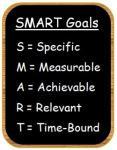This is a similar concept to creating a gratitute list. Not only as a positive means of charting where you are, but also taking pressure off when goal setting or expectations abound. Recovery can get full of goals and expectations. The nature of the eating disorder illness makes goals and expectations are hard thing to achieve during the early illness and into mid recovery and often set up failure. Goals also have a nasty habit of having deadlines attached to them – fail the deadline, fail yourself. Half the problem of goal setting, is they are usually set too high, or don’t meet the reality we live in.
 If your ready for goal setting and want it to be part of your recovery process, then our team supported the SMART Goal strategy – define clearly on several parameters your goal (small or large). The success rate and forward movement using SMART Goals is higher than just randomly choosing goals or having people set goals for you.
If your ready for goal setting and want it to be part of your recovery process, then our team supported the SMART Goal strategy – define clearly on several parameters your goal (small or large). The success rate and forward movement using SMART Goals is higher than just randomly choosing goals or having people set goals for you.
The below is a gentler way of looking a things, whilst providing the criticial positive reinforcement needed and takes away the ‘deadline’ overhead and definite goal setting. If your not ready for goals this is a gentler way in. It can help those in later recovery explore themselves – their personality, their uniqueness. So much can get lost or forgotten during the illness that getting back in touch with who you are is a very much needed exercise. Carers can also use the concept to see the path traveled so far, whether its on a personal level or how your loved one is going. It’s something I would have liked to known myself or for my daughter.
Thank you to Weightless – http://blogs.psychcentral.com/weightless/2015/01/this-new-year-focus-on-non-goals/
———————————————-
Recently, on her blog Design for Mankind, Erin Loechner shared her non-goals for the new year — something she’s been doing for several years now.
That is, instead of creating resolutions or intentions, Erin shares a list of qualities or traits or habits she’s learning to accept about herself.
As she writes beautifully in her post:
“In a month where we’re encouraged to pick apart bits of ourselves – more of this, less of that – sometimes it’s just refreshing to take a step back and see the landscape for what it is. To swim in the grace we’ve been given; leap in the forgiveness we’re granted. To just keep walking, one foot then another, without searching for a new route that might offer a quicker arrival to a destination we were never intended to seek.
And so, I do this every year on Jan 1st: a brief list of non-goals. Non-resolutions, non-changes, non-improvements. It’s a short list of things I’m learning to embrace about myself; things that make me uniquely… well, me.”
She writes about embracing everything from her need to rest to her thin skin.
I love this idea. I think it makes for a meaningful, compassionate practice, especially since, as Erin writes in her post, this month is all about measuring and evaluating ourselves, seeing where we come up short, criticizing ourselves for all sorts of habits or qualities or choices.
At the same time I can appreciate how difficult creating such a list can be. It’s hard to sit down, and think about the qualities or habits I’d like to accept and even embrace in myself. It’s hard because I’ve spent years doing the opposite — making lists in my head of all the things I needed to change, living life from a place of “I’m not enough” or “I can’t do that.”
Our brains tend toward negative thinking as it is. And if your inner critic is particularly boisterous, it might feel hard for you, too, to think about self-acceptance.
But let’s try anyway. The hardest part is getting started.
So here goes. Here’s my list of my non-goals, a combination of the things I’m learning to be OK with and learning to be proud of:
- You’re accomplishing something you never thought possible — writing a book. A book on one of your favorite topics (creativity!). A book that’s required months of self-reflection and sweat, going beyond the daily doubts that kept whispering and roaring (and, of course, still do): “who do you think you are to write this?!” or “what if this is utter crap, and they rip up your contract?”
- You’ve become more honest and vulnerable with yourself and with others. You’ve let people see the “you” you really are, from super talkative and silly to the sacred, scared parts of your heart. This is something important and beautiful and powerful that your husband has taught you. (Just writing the word “husband” makes you smile. Over and over. And that’s powerful, too.)
- You’ve surprised yourself. At so many pivotal moments in your life, you’ve worried that you’ll buckle, that you’ll shatter into a million little pieces. But you didn’t, and you haven’t. (And if you had, that’d be OK, too.) In some moments, in fact, you’ve remained calm and centered and present, taking in both the joy and heartache.
- You do most things slowly. Very slowly. Writing an email. Cleaning the tub. Washing the dishes. Organizing. Asking a question. Telling a story. Writing a blog post. You like to absorb the words, to taste them and turn them. This isn’t a bad thing. In fact, it’s how your father was. And that makes it extra sweet.
Create your own list of non-goals. Have 10 non-goals or one non-goal. Start where you are. Add to it regularly. This doesn’t have to be a practice we start and stop in January.
